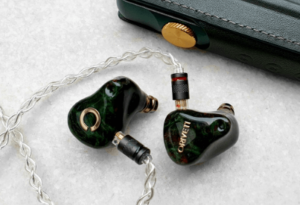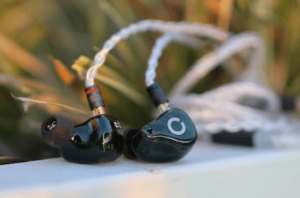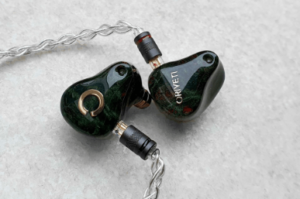The Oriveti OV800 is the company’s new flagship in-ear monitor based on the original O800.
The OV800 comes with several new features, such as a new sound tuning switch system, a more ergonomic monitor shape, a new faceplate design, and a handcrafted 8-core SPC wire cable.
Each OV800 monitor is equipped with eight balanced armature drivers: two for bass (Knowles), four for midrange, and two for treble.

The bass driver is a Knowles product, and the remaining six BA drivers for the midrange and high frequencies are balanced armature drivers developed in-house by Oriveti.
Oriveti OV800 IEM Review 2025
When it comes to audio quality, the Oriveti delivers excellent performance. The sound tuning is very agreeable and it’s easy to tell that this is an IEM that accepts balanced armature drivers due to their unique ‘flavor’.
But don’t get me wrong, this is not your typical BA IEM.
It offers dazzling technical capabilities, but it also has a soul that only dynamic driver IEMs can express.
You may have noticed that I titled this review article ‘Balanced Armatures Sound with Soul’. This is what I think of when I listen to Oriveti.
The treble is sweet and perfectly proportioned, although it’s not the most expansive treble (manufacturers these days tend to tone down the upper treble),
so I can’t even complain. The treble isn’t bright, but it has an excellent level of detail, and the fine detail and dynamics in the treble are truly amazing.

Even better, the treble is never harsh or overly bright and the proportions are perfect. It is not a thin BA treble, and the treble has some thickness and body, so it may lack extreme transparency and clarity a little.
Still, I’m enjoying it overall, it’s well-balanced, and if I had to express it, it’s ‘SWEET’.
The Midrange is consistent and forward, sounding thick, weighty, and detailed. I like the midrange presentation here.
It’s easy to express emotions and energy in the midrange, and there’s even a bit of ‘fluidity’ in the tone, so in short, the midrange is likable.
Sibilance is not an issue and I never felt the midrange was bright. Your toes will tap as you listen to the dynamic, soothing, and captivating midrange.
However, the midrange is not warm at all. Cleanliness and transparency are well maintained. Whatever it was, the midrange was really expertly tuned and showed the behavior of higher-end audiophile IEMs.
The bass is pleasant in the mid-bass and treble range, but don’t expect the elasticity and rumble of the dynamic drivers. The sub-bass soon gets recessed, so you can’t extend it from end to end here.
The bass is slightly beefed up, but I think that’s a good thing because, despite the slightly beefed-up bass, the timing and delivery are still on time,
which helps add to the musicality and ‘soul’ element of the music. Sometimes it sounds a bit ‘loud’.
But it’s still relatively clean and doesn’t get cloudy. What I expect from multi-BA IEMs is that the bass is fast, clean, and has good impact, but without much resonance or airiness.
Throughout the review, it’s no secret that I really like Oriveti. I love how Oriveti makes multi-BA IEMs that have a weighty, full-bodied tone and still have a great balance on the technical side.

The soundstage and imaging are great, but I think IEMs like the Moondrop S8 offer more layering and dimension in the soundstage, honestly, if you want the best soundstage and imaging, they’re not the first IEMs you should consider.
As I said, the timing is very timely and somewhat surprising. Most BAs sound very fast, but Oriveti doesn’t work that way.
The speed, although not very fast, is still on time and provides a good feeling of control. The overall tone is not that of a slow-timing IEM.
But in general, BA IEMs sound faster. Transient response performed below expectations for an IEM at this price, but relatively speaking it’s not a big deal.
The tone and timbre are great. To be honest, I had no reason not to like the sound. Well tuned, unless you hate BA kind of sound signature.
Conclusion of Oriveti OV800 Review

The OV800 surprised me considering the relatively recent release of the O800, and I was also surprised that Oriveti didn’t change the basic tuning of that model.
Nonetheless, this is not a bad thing for the O800 as a model I enjoyed very much, and the same could be said here. I didn’t find a tuning switch that offered a ton of adjustment, but having this flexibility isn’t a bad thing.
You can make small adjustments to user preference, listening volume, and even tip selection and fit depth. These are all very real and practical applications for such systems.
The execution is also sound, with both the bass and treble boosts being subtle and well-characterized, maintaining natural listening but slightly altering the voicing and positioning.
Unlike many of its competitors, there’s no clear “best” setting that most users will want to use, and at the same time, don’t expect it to change the character of the earphones.
Perhaps Oriveti would have benefited from releasing the original O800 with these features and it would have garnered more conversation.
Ultimately, if you’re already interested in the O800, Oriveti’s updated flagship offers greater versatility than before while remaining beautifully designed, sleek, and consistent.
However, the price surge makes it difficult to recommend that model if you’re not the fiddling type.
Also read: Sennheiser EW IEM G4 Twin Review
